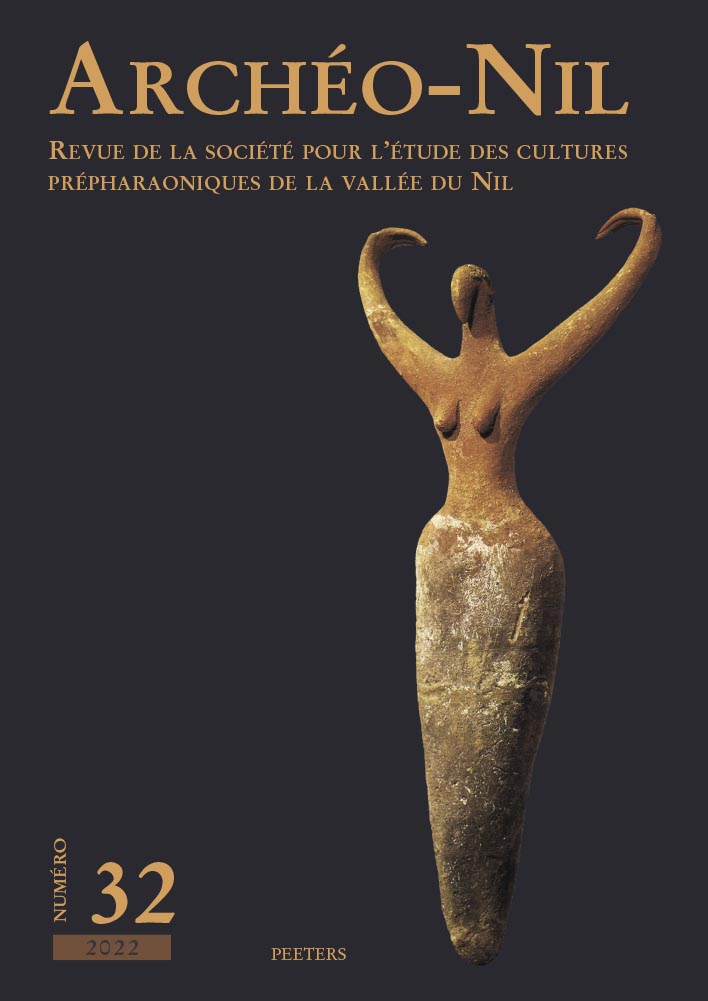 previous article in this issue previous article in this issue | next article in this issue  |

Preview first page |
Document Details : Title: Bringing the Desert to the Nile Subtitle: Some Thoughts on a Predynastic Terracotta Model Author(s): MAYDANA, Sebastián Francisco Journal: Archéo-Nil Volume: 31 Date: 2021 Pages: 61-80 DOI: 10.2143/ANI.31.0.3291286 Abstract : This article draws attention to an artefact in the Royal Ontario Museum in Canada, that has thus far received little attention despite having been in their archive for nearly a century. The object (ROM 900.2.45) is a heavily reconstructed terracotta rectangular-based model with openings to one side and on top. Painted and incised figures decorate the sides of the object. This paper presents a fresh approach regarding this particular artefact by addressing three issues that are intended to provide an insight into the symbolism of desert and Nile hunting. Firstly, I discuss its identification as a 'house', proposing instead that it may well resemble a Predynastic boat cabin. Secondly, I discuss the iconographic interpretation, showing that the scene painted in its 'narrow end A' is not a depiction of goats feeding their young, but rather a hunting scene. While this claim has been suggested by other Egyptologists as well, it is still possible to bring some new ideas to the discussion. Finally, I compare these findings with the available evidence and research conducted in the last few years to test this approach and propose an alternative interpretation to both the terracotta model and its painted scenes. This object can provide more information about a much-discussed topic: the apparent contradiction between desert hunting and river navigation. Cet article attire l’attention sur une œuvre conservée au Musée Royal de l’Ontario au Canada. Bien qu’elle ait rejoint les collections de cette institution il y a près d’un siècle, elle n’a que très peu attiré l’attention depuis. L’objet en question, catalogué sous le numéro 900.2.45, est un modèle à base rectangulaire en terre cuite fortement reconstruit et comportant des ouvertures sur une paroi et sur le dessus. Des décors peints et incisés ornent les flancs de l’objet. Je présenterai une approche renouvelée concernant cet artefact particulier au travers de l’analyse de trois problématiques, qui, je l’espère, contribueront à approfondir la question du symbolisme de la chasse dans le désert et dans le Nil. Tout d’abord, je vais discuter l’identification de l’objet à une maison, en proposant qu’il s’agisse plutôt d’une cabine de bateau prédynastique. Deuxièmement, je contesterai l’interprétation proposée il y a déjà trente ans en démontrant que la scène peinte dans son «extrémité étroite A» n’est pas une représentation de chèvres nourrissant leurs petits, mais plutôt une scène de chasse. Bien que cette affirmation ait déjà été proposée par d’autres égyptologues, il est encore possible de contribuer utilement à la discussion. Enfin, je propose de comparer ces résultats aux preuves disponibles et aux recherches effectuées au cours des dernières années, afin de tester cette approche et de proposer une interprétation alternative au modèle en terre cuite et à ses scènes peintes. Cet objet peut fournir davantage d’informations sur un sujet très discuté: l’apparente contradiction entre la chasse dans le désert et la navigation fluviale. |
|


